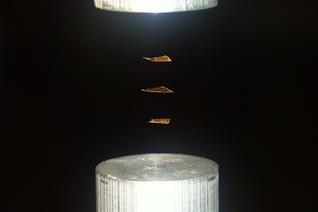Esta tarde a las 19:00 es la ceremonia de apertura de la Transmediale.09 DEEP NORTH en la House of World Cultures de Berlín. El evento incluye la participación de Evelina Domnitch y Dmitry Gelfand. Aunque sólo se puede entrar con invitación, será emitido en streaming a través de la página del festival para todo aquel que esté interesado. De todas formas, si estáis en Berlín y os interesa verlo en directo, la actuación volverá a repetirse mañana miércoles a las 20:00 dentro del programa abierto al público.
Dmitry Gelfand y Evelina Domnitch crean entornos inmersivos que unen física, química e informática con prácticas filosóficas extrañas. Su trabajo actual se centra sobre todo en fenómenos relacionados con las ondas, con el objetivo de investigar cuestiones en torno a la percepción y la constancia.
En esta ocasión, la pieza presentada se titula Sonolevitation, y consiste en suspender y mover láminas de oro en el aire usando vibraciones acusticas:
The reduction of gravitational effects may evoke emancipatory associations, yet such conditions predominate in our universe, and are in fact a significant obstacle for a variety of scientific research conducted beyond the Earth’s atmosphere. In a spacecraft, the only way to transport and position nearly all uncontained gases, liquids, and powders, is by means of a phenomenon known as acoustic levitation. Below on Earth, the selfsame phenomenon creates the impression of a localized absence of gravity, enabling the airborne levitation of fluids and solid matter.
A 15 kHz standing wave is generated between a transducer and a reflective surface: two waves sharing the same frequency and amplitude propagating with a 180 degree phase shift in opposite directions. Where the two waves superpose, the acoustic pressure is cancelled out, resulting in the formation of pressureless nodes that occur at half wavelength intervals — standing waves cannot arise unless they divide their medium into an integral quantity of half wavelengths. A high frequency, high amplitude standing wave, traveling through the air, creates tightly focused pressure fields that are strong enough to trap matter in the pressureless nodal cavities.
For this rendition of Sonolevitation, slivers of gold are acoustically suspended and spun in different directions at varying speeds. The spin reveals the rotary behavior of acoustic vibrations as well as the dynamics of frictionless motion (untainted by gravitational forces). A close-range microphone monitors the slivers’ modulation of the levitatory standing wave: the slightest turbulence or change in spin has highly audible consequences. The slivers also interact with each other, modifying one another’s spin patterns.
Because optical radiation similarly exerts pressure on matter in a nodal fashion, precise analogies of frequency, wavelength and particle size can be made between acoustic and electromagnetic levitators. As such, sonic ‘force field tailoring’ serves as an ideal testing ground for colossal, long-wave electromagnetic levitators that will be a critical necessity for automated architectural engineering in microgravity. Acoustically levitated materials can also be efficaciously sculpted by sound fields, with specific variations in density that can turn free hanging micro-droplets of liquid into highly sensitive optical resonators, capable of lasing and intra-cavity absorbance.
‘Space’ exploration is not only imperative for scientific and survivalist reasons, but also for purely aesthetic ends. Sonolevitation is the first in a series of projects in preparation for microgravitational, near-vacuous environments. The capacity to create artworks in large-scale vacuums (much larger than the ones that could ever be produced on Earth) permits the actuation of altogether unforeseen optical and acoustic processes.



Leave a Reply
Lo siento, debes estar conectado para publicar un comentario.